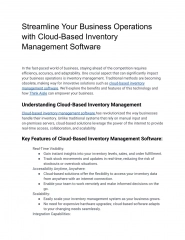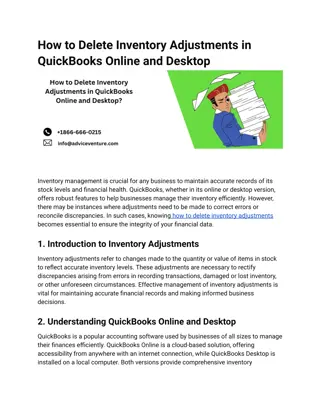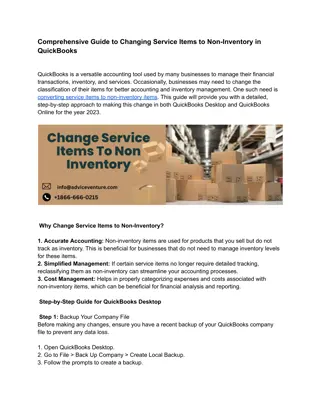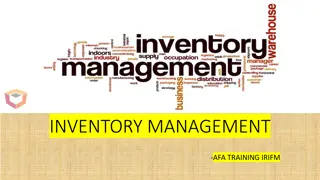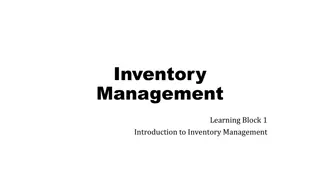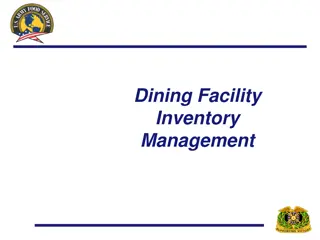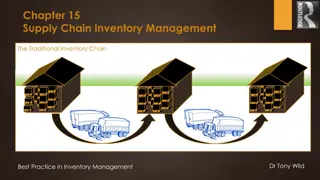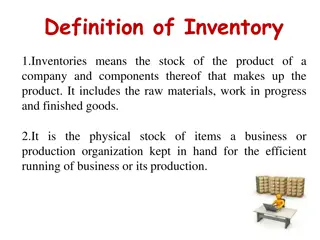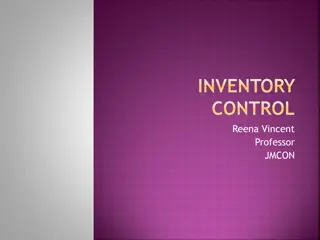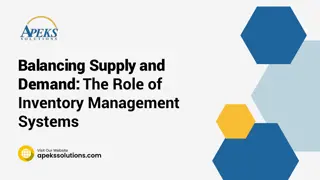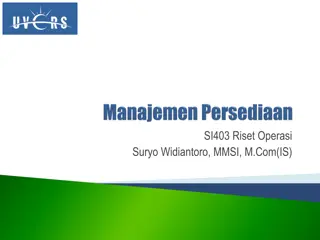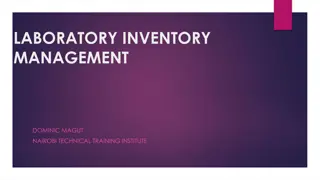Managing Inventory for Better Business Profitability
Planning and managing inventory effectively is crucial for business success. Learn how to optimize stock levels, control inventory flow, and ensure customer satisfaction. Discover key benefits, tools, and techniques for efficient inventory management that boosts profitability.
Download Presentation

Please find below an Image/Link to download the presentation.
The content on the website is provided AS IS for your information and personal use only. It may not be sold, licensed, or shared on other websites without obtaining consent from the author.If you encounter any issues during the download, it is possible that the publisher has removed the file from their server.
You are allowed to download the files provided on this website for personal or commercial use, subject to the condition that they are used lawfully. All files are the property of their respective owners.
The content on the website is provided AS IS for your information and personal use only. It may not be sold, licensed, or shared on other websites without obtaining consent from the author.
E N D
Presentation Transcript
Entrepreneur Entrepreneur Local Learning Centers Local Learning Centers
SEMINAR 26: HOW TO MANAGE INVENTORY For a business to be profitable, it must understand customers needs and stock the required goods to supply their demands. To do this, a small business must know its stock inside and out; to do that, a business must have inventory management.
The Benefits of Good Management As you already know, planning is the key in business! Suppose you run a clothing store that sells outdoor gear, then your physical inventory will be made up of hats, scarves, jackets, and gloves. You will need to be well-stocked according to the seasons! This also means planning production or with distributors. Inefficient inventory management leads to: - Not having the right products at the right time - A surplus in inventory must be sold at liquidation prices (loss of profits). - Valuable liquidity buried in your warehouses or on the shelves. Bad inventory management is costly!
What is Inventory Management? Managing inventory at a warehouse level is all about providing knowledge and control of your inventory, such as what supplies need to be ordered and when, while always keeping an eye on the quantities and movement of your stock. Increasing your working capital: Identify the top performers, align products with customer demand and fine-tune your inventory planning strategies to ensure you never run out of any high-margin product. Monitoring inventory levels: - Knowing the volume of items in stock, what s about to go out of date, and what needs to be sold immediately. Continued
Inventory Management Cont d. At a retail store level, Merchandise Management, combined with marketing techniques, helps retailers decide what items to carry, how much to have on hand to meet customers' needs, and where and how they should be displayed in the store to maximize sales and profits. It also involves organizing merchandise on shelves and displays in an appealing way to engage and inspire shoppers to buy. Here are simple inventory management tools/ methods to keep an eye on your inventory levels and cost: Physical inventory count Reorder levels LIFO/FIFO Excel sheets Using inventory or accounting software
Physical Inventory Count - Physical inventory is the actual count of a business s products and materials. This process ensures that the exact number of products on the company s sales floor, stockroom, and warehouses match the numbers corresponding with the company s financial books. - The physical count is used to adjust the Inventory account balance to the available inventory. The physical count is used to determine if there has been any inventory theft, loss, damage, or errors. - A physical inventory count should be performed at least once yearly, but more frequent checks can be helpful. You will optimize your stock management and efficiency by checking your stock periodically. - Depending on your inventory scale, UPC and EAN barcode scanning speeds up this process and reduces human error. You can also use rough calculations for small items to be easily counted.
Managing Reorder Levels The reorder level formula is used in inventory management to identify when to issue a purchase order to replenish the amount on hand. When calculated correctly, the reorder level should result in replenished inventory arriving just as the existing inventory quantity has declined to zero if you use just-in-time methods or the safety stock level. To illustrate the concept: Reorder level = average demand lead time + safety stock. - Lead time: is the time it takes to receive a shipment of inventory after placing your order. - Safety stock: the extra quantity of a product stored in the warehouse to prevent an out-of- stock situation. It serves as insurance against fluctuations in demand. - Average demand is the number or quantity of a particular item you sell or use within a given time. Continued
Managing Reorder Levels, Cont d. To illustrate the reordering level: Kuujjuaq Colorful Scarves wants to determine the reorder level to help plan the production cycle. They first identify their average demand by counting the number of scarves they sell in a given period. Since the demand varies, they calculate sales for several days and determine that they sell an average of 96 scarves monthly. Next, they figure out their lead time. Their production lead time generally takes 30 days to place an order of fabric and produce the scarves. To be consistent, they remember to use the month as their unit of time to match what they used to find their average demand. Kuujjuaq Colorful Scarves chooses to keep a safety stock on hand because customers, especially tourists, cannot wait for the following order of products. Even if it costs money to store extra inventory, they always keep 50 scarves in stock. Continued
Reorder level = average demand lead time + safety stock Reorder level = 97 scarves per months x 1 month + 45 scarves Reorder level = 147 Once the ending inventory is close to or under 147.00 scarves, Kuujjuaq Colorful Scarves knows they need to start the production process to build stock. Kuujjuaq Colorful Scarves, Inventory and Reordering Chart March April May June July Total January February August September October November December In quantity Beginning inventory - 130.00 100.00 70.00 160.00 90.00 156.00 66.00 153.00 78.00 118.00 153.00 Inventory purchase ( +) Sold products cost ( - ) 150.00 150.00 150.00 150.00 150.00 150.00 150.00 1 050.00 20.00 30.00 30.00 60.00 70.00 84.00 90.00 63.00 75.00 110.00 115.00 115.00 862.00 Ending inventory 130.00 100.00 70.00 160.00 90.00 156.00 66.00 153.00 78.00 118.00 153.00** 188.00 *** Restocking was necessary in December to keep a year s end level over the reordering level.
LIFO/FIFO Inventory Accounting Management Methods: These two acronyms are related to managing inventory methods of goods in warehouses. These techniques are based on the entry and exit dates of raw materials or finished products in inventory. FIFO ( First-In, First-Out ) assumes that the oldest products in inventory have been sold first. The goal of FIFO is to ensure the oldest stock is used first to reduce costs associated with obsolete inventory. The LIFO ( Last-In, First-Out ) method assumes that the most recent products in a company's inventory have been sold first and uses those costs instead. The technique is often used for non-perishable products or those with a low turnover rate. Which method is better, LIFO or FIFO? FIFO and LIFO allow businesses to calculate the cost of goods differently. From a tax perspective, FIFO is more advantageous for companies with steady product prices, while LIFO is better for businesses with rising product prices. Continued
FIFO Versus LIFO However, the Canada Revenue Agency and International Financial Reporting Standards don t allow using LIFO for inventory for financial reporting or tax purposes. The method understates a company's earnings and therefore results in low taxable income. - LIFO accounting benefits your business for your internal records. LIFO improves income matching statements when you analyze your current expenses. To illustrate the FIFO method cost of goods:your company purchased 100 items for $12 each, then restocked 100 more items later that year but at $20 each. When the company sold 75 items. Under the FIFO method, the cost of goods sold for each 75 items is $12/unit because the first goods purchased are the first goods sold. To illustrate the LIFO method cost of goods: your company purchased 100 items for $12 each, then restocked 100 more items later that year at $20 each. When the company sold 75 items. Under the LIFO method, the cost of goods sold for each of the 75 items is $20/unit because the last (most recent) goods purchased are the first goods sold.
Inventory Management Software Advantage Keep track of your inventory in real-time compared to an excel sheet and prevent product and production shortages. Help you forecast demand based on past transactions and prevent excess stock or raw materials. Allow for easy inventory analysis on any device. Be accessible right from your retail point of sales. Optimize warehouse organization and precious employee time. Offer quick and painless bar code scanning to speed up the intake. Allow for multi-location management, tracking inventory across several locations or warehouses. Reduce costs, and improve cash flow! For Future Reference:
Scenario: Scenario: Tivi Galleries wants to determine the reorder level for the Kuujjuaq Colorful Scarves collection. They first identify their average demand by counting the number of scarves they sell in a given period. Since the demand varies, they calculate sales for several days and determine that they sell an average of 3 scarves daily. Next, they figure out their lead time. Their supplier and shipping service are generally reliable, and it takes an average of 30 days to receive a shipment after placing an order. Although 30 days can be communicated as one month, they remember to use days as their unit of time to match how they calculated average demand. Tivi Galleries chooses to keep a safety stock on hand because customers, especially tourists, cannot wait for the following order of products. Even if it costs money to store extra inventory, they always keep three scarves in stock. Once you are ready, click here to progress to the quiz. You may return to this slide at any time to help in your answers.
Using the Scenario, Answer the Following Questions. Click here to return to the scenario page Click here to return to the scenario page 1. How is reorder level calculated? A. A. Average demand lead time + safety stock B. Average demand + lead time - Overstock B. C. Reorder level doesn t need to be calculated; it s the same amount for every period C.
2. What does the Reorder Level Look Like in the Numbers of this Scenario? 2. What does the Reorder Level Look Like in the Numbers of this Scenario? A. 3 Scarves per day of the month + Overstock (variable) A. B. 3 Scarves per day x 1 month + 3 scarves B. C. 3 scarves per day x 30 days + 3 scarves C. Click here to return to the scenario page Click here to return to the scenario page
3. Now that we know the exact reorder level, what does this mean for Tivi 3. Now that we know the exact reorder level, what does this mean for Tivi Galleries? Galleries? A. A. - Before the stock reaches 93 scarves, Tivi Galleries must place an order as soon as possible B. - Tivi Galleries must tell Kuujjuaq Colourful Scarves to send them an order of 93 scarves at the end of each month B. C. - Once the stock at 93 scarves, Tivi Galleries knows they need to place an order C.
Glossary Click on the word to go back to that slide. - Stock: Stock can be considered as another term for inventory: it means items that are held by the seller which are available and directly sold to customers. - UPC: A UPC, which stands for Universal Product Code, is a 12-digit bar code used primarily in Canada and the United States. Retailers add UPCs to each item they sell in order to track their product inventory - EAN: EAN originally stood for "European Article Number," but has since been changed to "International Article Number." The term refers to the bar code used by retailers outside of North America.
Congratulations, you are correct! Click here to continue. Click here to continue.
Sorry. Please try again. Click here to try again. Click here to try again.
Congratulations, you are correct! This means the reorder level is 93 scarves (3x30+3) Click here to continue. Click here to continue.
Sorry. Please try again. Click here to try again. Click here to try again.
Congratulations, you are correct! Click here to continue. Click here to continue.
Sorry. Please try again. Click here to try again. Click here to try again.


